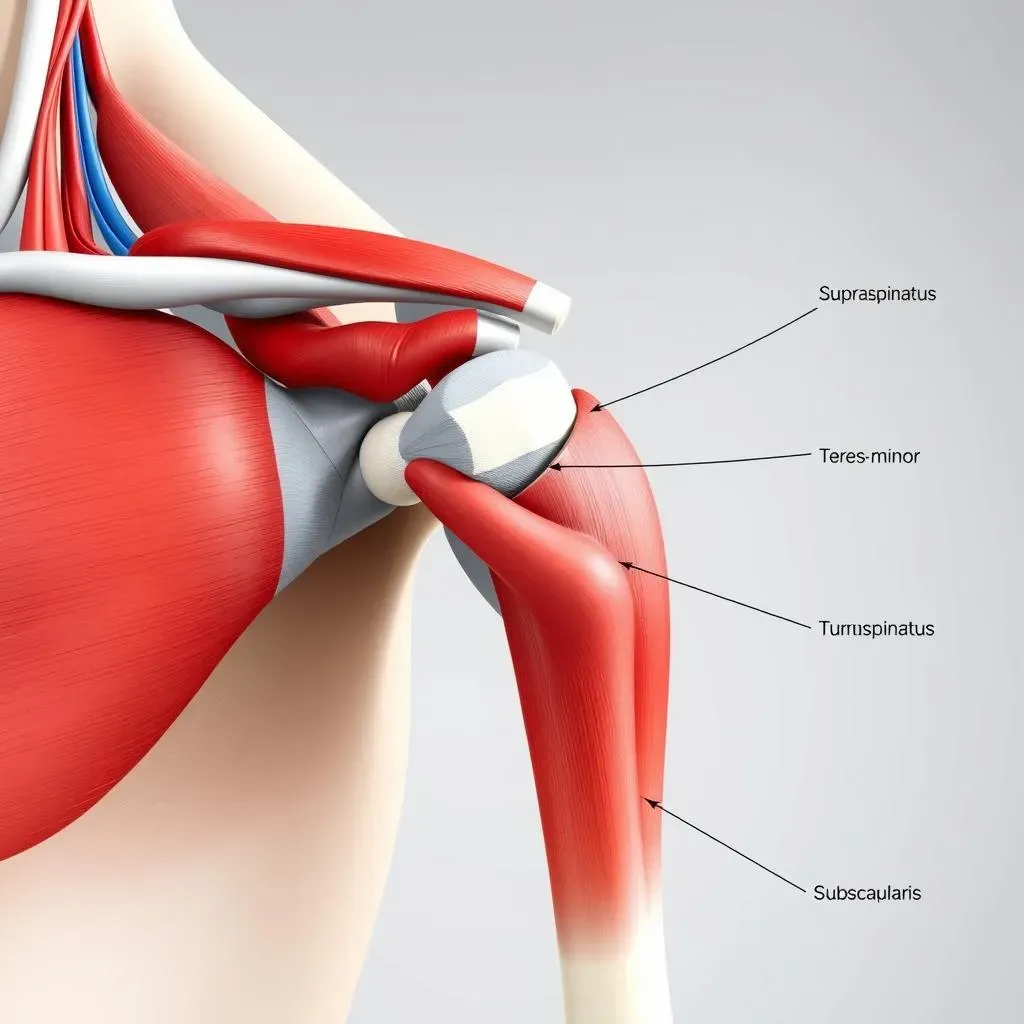Table of Contents
Want boulder shoulders that not only look great but also function like a well-oiled machine? Forget endless hours with dumbbells – the secret weapon you need is a kettlebell. This article dives deep into the world of the kettlebell shoulder circuit, a dynamic and effective way to build strength, improve mobility, and sculpt your deltoids. We'll break down the essential exercises, from the foundational Turkish Get-Up to the powerful Kettlebell Press, showing you how to target every angle of your shoulder.
Understanding the Shoulder: Anatomy & Function

Understanding the Shoulder: Anatomy & Function
Before we start slinging kettlebells around, let's get acquainted with the star of the show: your shoulder. It's not just one thing, but a complex ball-and-socket joint made up of several muscles, ligaments, and tendons working together. Think of it as a super talented orchestra, and you want to make sure every instrument is playing its part in harmony. The main players are the deltoids (the rounded muscle on top of your shoulder), which are responsible for lifting and rotating your arm. Then you've got the rotator cuff, a group of four muscles that stabilize the joint and allow for a wide range of motion. Neglecting any of these components is like asking a guitarist to play a solo with only three strings – it's just not going to sound right.
Understanding the shoulder joint is key to preventing injuries and maximizing the effectiveness of your kettlebell training. The shoulder, being the most mobile joint in the body, is inherently less stable. This instability, combined with the complexity of its structure, makes it prone to injury if not properly trained and cared for. It is important to remember that each part of the shoulder plays a crucial role in its overall function, so a balanced approach to training is necessary.
Kettlebell Exercises for a Killer Shoulder Circuit

Kettlebell Exercises for a Killer Shoulder Circuit
The "Get-Up-and-Go" Exercise: Turkish Get-Up
Alright, let's talk about the heavy hitters. The Turkish Get-Up (TGU) isn't just a shoulder exercise; it's a full-body symphony of strength and coordination. Seriously, if you could only do one exercise for the rest of your life, the TGU wouldn't be a bad choice. It hits your shoulders from every conceivable angle, building stability and mobility like nothing else. It starts with you lying on the ground, kettlebell in hand, and ends with you standing tall, the kettlebell overhead. Sounds simple? Trust me, it's a humbling experience, especially when you start adding weight. But the payoff is huge: bulletproof shoulders, a rock-solid core, and a newfound appreciation for the simple act of standing up.
The TGU is more than just lifting weight; it's about control, precision, and body awareness. Each transition from the ground to standing requires focus and deliberate movement. This not only strengthens the shoulder muscles but also improves overall coordination and stability. As you progress, the TGU becomes a moving meditation, challenging both your body and mind. Don't rush the process; master each step before adding weight, and your shoulders will thank you for it. Start light, focus on form, and gradually increase the challenge as you get stronger. The TGU is a journey, not a race.
Here’s a breakdown:
- Lie on your back, kettlebell in right hand, right knee bent.
- Press the kettlebell straight up, keeping your wrist locked.
- Use your left arm to post as you roll onto your left forearm.
- Push up to a seated position, then sweep your left leg back into a lunge.
- Stand up, keeping the kettlebell overhead.
- Reverse the steps to return to the starting position.
Pressing Matters: Push Press & Clean and Press
Now, let's move onto some pressing variations. The Push Press and Clean and Press are fantastic for building raw shoulder strength and power. The Push Press uses a slight dip and drive from your legs to help propel the kettlebell overhead, allowing you to lift heavier weight than a strict shoulder press. The Clean and Press adds a dynamic "clean" movement to bring the kettlebell into the rack position before pressing, engaging your entire body and boosting your metabolic rate. These exercises are great for developing explosive power and building serious shoulder muscle. Plus, they're just plain fun to do.
The key to both the Push Press and Clean and Press is maintaining a solid core and proper form. Avoid arching your back or using excessive momentum to swing the kettlebell up. Focus on controlled movements and engaging your shoulder muscles to do the work. These exercises not only build strength but also improve coordination and stability, making them valuable additions to any kettlebell shoulder circuit. Remember to start with a weight that allows you to maintain good form throughout the entire range of motion. As you get stronger, gradually increase the weight to continue challenging your muscles and promoting growth.
Check out this table comparing the two:
Exercise | Focus | Benefits |
|---|---|---|
Push Press | Power & Strength | Heavier weight, explosive movement |
Clean and Press | Full Body & Conditioning | Dynamic clean, metabolic boost |
Designing Your Own Kettlebell Shoulder Circuit

Designing Your Own Kettlebell Shoulder Circuit
Choosing the Right Exercises
So, you're ready to build your own kettlebell shoulder circuit? Awesome! The first step is picking the right exercises. Think about what you want to achieve. Are you looking for pure strength, improved mobility, or a combination of both? For strength, focus on presses and heavier lifts. For mobility, incorporate exercises like the Turkish Get-Up and Windmill. And don't forget to consider your current fitness level. Start with lighter weights and simpler movements, gradually progressing as you get stronger. It's like building a house – you need a solid foundation before you can start adding fancy features.
Consider these questions when choosing exercises:
- What are your specific goals (strength, mobility, endurance)?
- What is your current fitness level?
- Do you have any existing shoulder injuries or limitations?
- Which exercises do you enjoy and feel comfortable performing?
Structuring Your Circuit: Sets, Reps & Rest
Now that you've chosen your exercises, it's time to structure your circuit. There's no one-size-fits-all approach here, so experiment and find what works best for you. A good starting point is 3-4 rounds of 8-12 repetitions per exercise, with 60-90 seconds of rest between rounds. However, feel free to adjust these parameters based on your goals and fitness level. If you're focusing on strength, you might opt for lower reps (5-8) with heavier weight and longer rest periods. If you're aiming for endurance, try higher reps (15-20) with lighter weight and shorter rest periods. The key is to challenge yourself without sacrificing form.
Here's a sample circuit structure for different fitness levels:
Fitness Level | Sets | Reps | Rest |
|---|---|---|---|
Beginner | 3 | 8-12 | 90 seconds |
Intermediate | 4 | 10-15 | 75 seconds |
Advanced | 4-5 | 12-20 | 60 seconds |
Progressive Overload: Keeping the Gains Coming
The final piece of the puzzle is progressive overload. This simply means gradually increasing the demands on your muscles over time. If you keep doing the same exercises with the same weight and the same reps, your body will adapt, and you'll stop seeing results. There are several ways to implement progressive overload in your kettlebell shoulder circuit. You can increase the weight, add more reps, reduce rest periods, or try more challenging variations of the exercises. The important thing is to consistently push yourself outside of your comfort zone, without compromising your form. Remember, small, consistent progress is better than trying to do too much too soon and risking injury.
As the saying goes:
Maximizing Results: Form, Progression & Recovery for Your Kettlebell Shoulder Circuit

Maximizing Results: Form, Progression & Recovery for Your Kettlebell Shoulder Circuit
Nailing the Form: Quality Over Quantity
Look, I get it. It's tempting to just throw the kettlebell around and try to lift as heavy as possible. But trust me, when it comes to kettlebell training, form is king (or queen!). If your form is sloppy, you're not only reducing the effectiveness of the exercise but also significantly increasing your risk of injury. Focus on controlled movements, engaging the right muscles, and maintaining a neutral spine. It's better to lift lighter with perfect form than to struggle with a heavier weight and compromise your technique. Record yourself performing the exercises and compare it to videos of experienced kettlebell practitioners. It might be a humbling experience, but it's the fastest way to identify and correct any flaws in your form.
Here are some key form pointers for common kettlebell shoulder exercises:
- Turkish Get-Up: Maintain a straight line from your hand to your shoulder throughout the entire movement.
- Push Press: Use a slight dip and drive from your legs, but avoid turning it into a full-blown squat.
- Clean and Press: Keep the kettlebell close to your body during the clean, and avoid yanking it up with your arms.
Recovery is Key: Rest, Nutrition & Mobility
You're crushing your kettlebell shoulder circuits, feeling stronger every day. But remember, all that hard work is only half the battle. Your body needs time to recover and rebuild. Neglecting recovery is like trying to drive a race car with flat tires – you're not going to get very far. Prioritize sleep, aim for at least 7-8 hours of quality sleep per night. Fuel your body with nutritious foods, focusing on protein to repair muscle tissue and complex carbohydrates to replenish energy stores. And don't forget about mobility work. Stretching and foam rolling can help improve flexibility, reduce muscle soreness, and prevent injuries. Think of recovery as an investment in your long-term progress, not a luxury.
Here is a quick guide to recovery strategies:
Strategy | Benefits |
|---|---|
Sleep | Muscle repair, hormone regulation |
Nutrition | Fueling workouts, muscle building |
Mobility | Flexibility, injury prevention |
Unleash Your Shoulder Strength: The Kettlebell Advantage
The kettlebell shoulder circuit offers a potent blend of strength, mobility, and functional fitness. By understanding the nuances of each exercise, designing smart circuits, and prioritizing form and recovery, you unlock the potential for well-rounded shoulder development. Consistency is key, and remember to listen to your body. So, grab that kettlebell, dial in your focus, and embark on the journey to stronger, healthier, and more resilient shoulders.